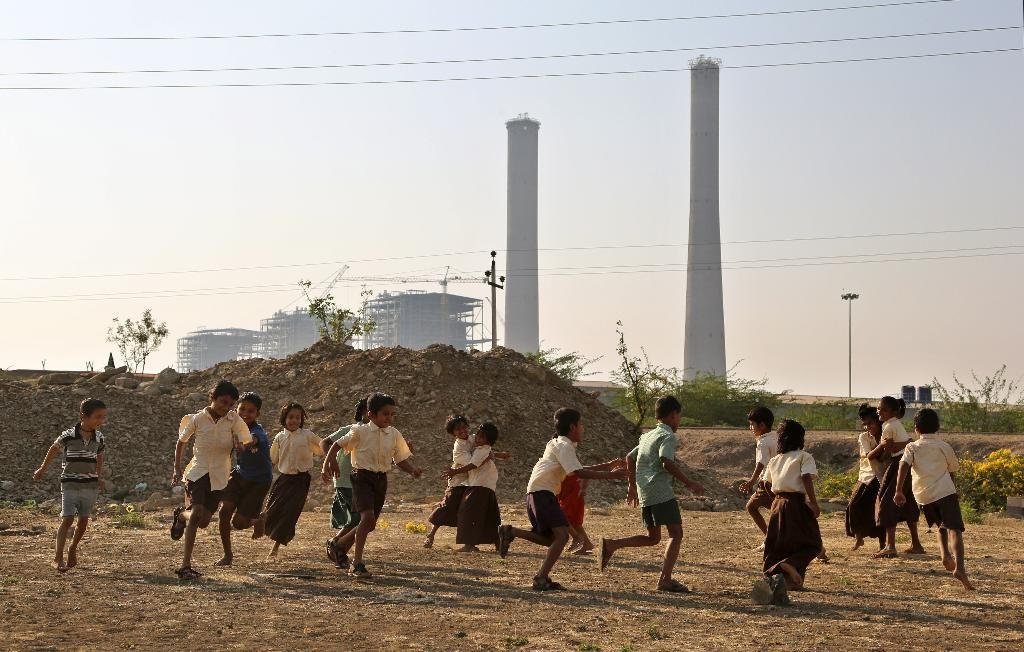- California Assembly OKs highest minimum wage in nation
- S. Korea unveils first graphic cigarette warnings
- US joins with South Korea, Japan in bid to deter North Korea
- LPGA golfer Chun In-gee finally back in action
- S. Korea won’t be top seed in final World Cup qualification round
- US men’s soccer misses 2nd straight Olympics
- US back on track in qualifying with 4-0 win over Guatemala
- High-intensity workout injuries spawn cottage industry
- CDC expands range of Zika mosquitoes into parts of Northeast
- Who knew? ‘The Walking Dead’ is helping families connect
Japan uses $1 billion climate change fund for coal plants in India, Bangladesh

In this Tuesday, Feb. 24, 2015 photo, children play in front of chimneys standing at an under- construction coal-fired power plant, partially financed by the Japan Bank for International Cooperation, in Kudgi, India. Despite mounting protests, Japan continues to finance the building of coal-fired power plants with money earmarked for fighting climate change, with two new projects underway in India and Bangladesh, The Associated Press has found. (AP Photo/Aijaz Rahi)
MUTTAGI, India (AP) — Despite mounting protests, Japan continues to finance the building of coal-fired power plants with money earmarked for fighting climate change, with two new projects underway in India and Bangladesh, The Associated Press has found.
The AP reported in December that Japan had counted $1 billion in loans for coal plants in Indonesia as climate finance, angering critics who say such financing should be going to clean energy like solar and wind power.
Japanese officials now say they are also counting $630 million in loans for coal plants in Kudgi, India, and Matarbari, Bangladesh, as climate finance. The Kudgi project has been marred by violent clashes between police and local farmers who fear the plant will pollute the environment.
Tokyo argues that the projects are climate-friendly because the plants use technology that burns coal more efficiently, reducing their carbon emissions compared to older coal plants. Also, Japanese officials stress that developing countries need coal power to grow their economies and expand access to electricity.
“Japan is of the view that the promotion of high-efficiency coal-fired power plants is one of the realistic, pragmatic and effective approaches to cope with the issue of climate change,” said Takako Ito, a spokeswoman for the Foreign Ministry.
Climate finance is money promised by rich countries in U.N. climate talks to help poor countries limit their carbon emissions. Japan announced at a U.N. climate conference in Peru in December that it has provided $16 billion in climate finance since 2013. Yet the U.N. has no rules defining climate finance, meaning governments decide for themselves what projects to include in their accounting.
Environmental activists are demanding that at the very least, climate finance should exclude coal and other fossil fuels that scientists blame for warming the planet.
“Japan’s support for new coal-fired power plants not only destroys the climate — it also displaces communities, is likely to cause untold local environmental damage, and primarily benefits Japanese companies instead of recipient countries,” said Brandon Wu of ActionAid.
“This is unacceptable on its own, and the fact that it is being done in the name of ‘climate finance’ makes a farce of the entire concept,” he said.
Climate activists are now urging the recently created Green Climate Fund, which is supposed to become a key channel of climate finance, to explicitly ban funding for fossil fuel projects. The issue is likely to be discussed at the GCF’s board meeting this week in South Korea.
The Matarbari plant is financed with a Japanese development loan agreed with the government of Bangladesh last June.
The Kudgi project is partially financed by the Japan Bank for International Cooperation, which supports Japanese companies abroad through export credits. JBIC agreed in January 2014 to provide $210 million in loans to Indian power company NTPC Ltd. to finance the purchase of steam turbine generators and boiler feed water pumps to be used in the coal plant from a local subsidiary of Toshiba, a major Japanese company.
Construction there has resumed after coming to a standstill following violent protests last July when police opened fire on angry demonstrators. Two farmers were wounded in the shootings.
One of them, Chandappa Holleppa, said he was shot in the stomach and left hand.
“I fell on the road and was bleeding badly,” he told the AP. “Policemen picked me up and took me to a hospital,” where he remained for two months, he said.
The protesters have set up a makeshift shed of bamboo sticks and tin sheets and plastic in the nearby village of Muttagi. They are focused on the plant’s local environmental impact, such as potential air pollution, rather than its contribution to global carbon emissions.
“We want more power but not this one,” said Sidramappa Ranjanagi, who leads a local farmers’ organization. “In America they have stopped coal-based plants because it affects people’s health. Why can’t the government come up with solar power plants? We use solar power units at home here and they’re good.”
A. Sathyabhama, a technical services manager at the plant, said NTPC is trying to assure the villagers that the plant is environmentally safe.
Japanese environmental activist Yuki Tanabe has met with JBIC officials several times to urge them to withdraw funding for the Kudgi plant, citing concerns over human rights violations and environmental damage.
“JBIC responded that the human rights situation has been improved, and environmental concerns have been addressed,” Tanabe said. “The project was approved, and no possibility to stop it now.”
Japan’s Foreign Ministry, which compiles the list of projects that get the climate finance label, said there was no change in policy regarding Kudgi.
“We are aware that the project mentioned was temporarily halted due to the protests by local residents,” Ito said. “But we also understand that the project company responded to them properly and the project is being continued with appropriate monitoring in line with JBIC guidelines” for environmental and social considerations.
















Pingback: Japan uses $1 billion climate change fund for coal plants in India, Bangladesh | seemsleg.it
Andrew
March 25, 2015 at 6:23 PM
Hard to say here who to side with, honestly. On one hand, they are right, developing countries could really use the energy. On the other, everything I’ve been taught about coal is that theres no such thing as clean coal. But this is Japan we are talking about, if anyone can develop a plant to form a semblance of clean coal, it’d be them.
Honestly I’d say it should come down to if it really has the local impact or not.
tumaru
March 25, 2015 at 8:39 PM
Would it have been better if they had gone with the far cleaner gas powered generators or would the extra costs have been too much for the countries in question?
Pingback: Newslyne - News » Japan uses $1 billion climate change fund for coal plants in India, Bangladesh
Zomby Poet
March 26, 2015 at 6:35 AM
I am thinking that it is only western dupes who don’t know that it is about income redistribution not Global Warming or Climate Change.
factcheck
March 27, 2015 at 4:46 AM
Read this and laugh. I agree with all of you but Zomby Poet has right….
The Washington Post
The Arctic Ocean is warming up, icebergs are growing scarcer and in
some places the seals are finding the water too hot, according to a
report to the Commerce Department yesterday from Consulafft, at
Bergen , Norway .
Reports from fishermen, seal hunters and explorers all point to a
radical change in climate conditions and hitherto unheard-of
temperatures in the Arctic zone. Exploration expeditions report
that scarcely any ice has been met as far north as 81 degrees 29 minutes.
Soundings to a depth of 3,100 meters showed the gulf stream still
very warm. Great masses of ice have been replaced by moraines of
earth and stones, the report continued, while at many points well
known glaciers have entirely disappeared.
Very few seals and no white fish are found in the eastern Arctic,
while vast shoals of herring and smelts which have never before
ventured so far north, are being encountered in the old seal fishing
grounds. Within a few years it is predicted that due to the ice
melt the sea will rise and make most coastal cities uninhabitable.
* * * * * * * * *
I must apologize, I neglected to mention that this report was
from November 2, 1922, as reported by the AP and published in The
Washington Post – 93 years ago.
The debate continues………………….Don’t tell Al Gore
Avast logo
This email has been checked for viruses by Avast antivirus software.
http://www.avast.com
kelly
November 24, 2017 at 11:03 AM
Very nice and always successful.
This is a very good article.
I’m waiting for you the other article.
togel online